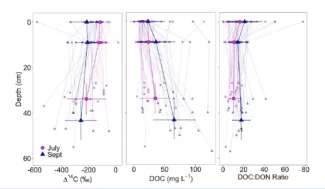Deepening of the thaw layer resulted in increased concentrations and age of DOC in surface and pore waters that may contribute to greenhouse gas emissions as warming increases permafrost thaw.
Radiocarbon (14C) age of DOC and assessment of DOC composition with ultraviolet-visible spectroscopy of surface waters and shallow and deep subsurface pore waters from 17 drainages in the Barrow Environmental Observatory in Alaska were used to identify where and under what conditions permafrost DOC is mobilized. Samples were collected in July and September 2013 to assess changes in age and chemistry of DOC over time. DOC age was highly variable, ranging from modern to approximately 7,000 yBP. DOC age increased with depth, over the summer as the active layer deepened, and with increasing drainage size. DOC quality indicators reflected a DOC source rich in high–molecular weight and aromatic compounds—characteristics consistent with vegetation-derived organic matter that had undergone little microbial processing—throughout the summer, and a weak relationship with DOC age. In deep pore waters, DOC age was also correlated with several biogeochemical indicators (including dissolved CH4 concentration, δ13C, and the apparent fractionation factor), suggesting a coupling between carbon and redox biogeochemistry influencing CH4 production. In the drained thawed lake basins examined in this study, DOC concentrations and contributions of vegetation-derived organic matter declined with increasing basin age. The weak relationship between DOC age and chemistry and consistency in DOC chemical indicators over the summer suggest a high lability of old DOC released by thawing permafrost.


